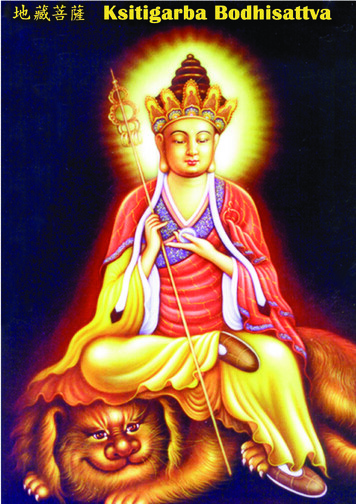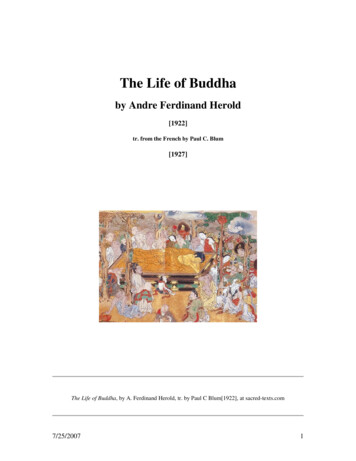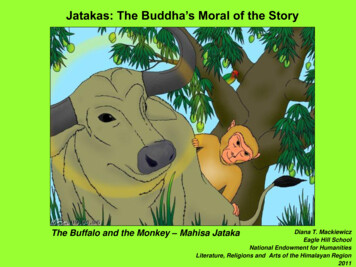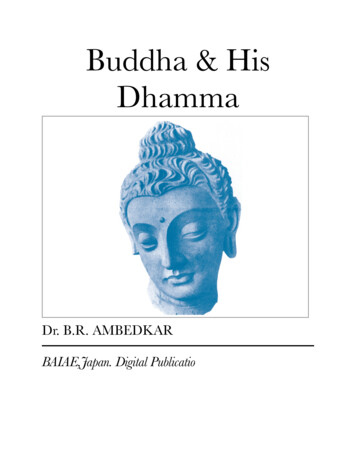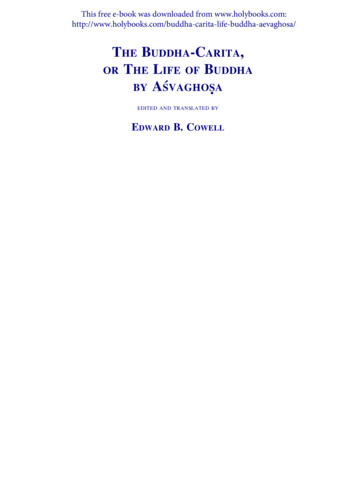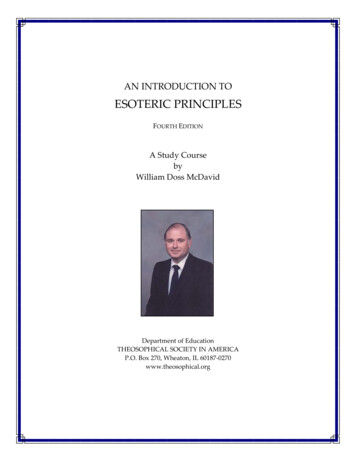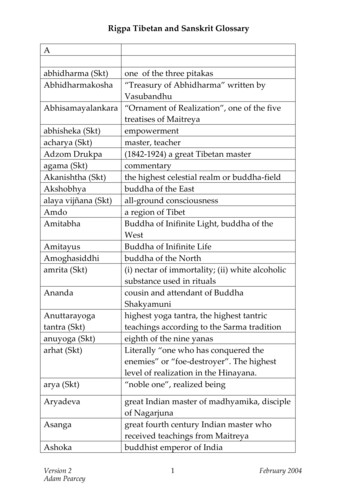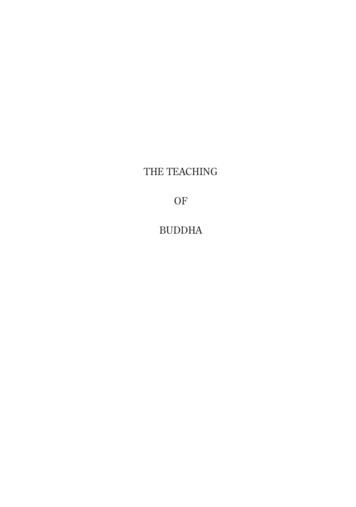
Transcription
THE TEACHINGOFBUDDHA
WHEEL OF DHARMAThe Wheel of Dharma is the translation of the Sanskrit word,“Dharmacakra.” Similar to the wheel of a cart that keeps revolving, it symbolizesthe Buddha’s teaching as it continues to be spread widely and endlessly. Theeight spokes of the wheel represent the Noble Eightfold Path of Buddhism, themost important Way of Practice. The Noble Eightfold Path refers to right view,right thought, right speech, right behavior, right livelihood, right effort, rightmindfulness, and right meditation. In the olden days before statues and otherimages of the Buddha were made, this Wheel of Dharma served as the object ofworship. At the present time, the Wheel is used internationally as the commonsymbol of Buddhism.
Copyright 1962, 1972, 2005 by BUKKYO DENDO KYOKAIAny part of this book may be quoted without permission.We only ask that Bukkyo Dendo Kyokai, Tokyo, becredited and that a copy of the publication sent to us.Thank you.BUKKYO DENDO KYOKAI(Society for the Promotion of Buddhism)3-14, Shiba 4-chome,Minato-ku, Tokyo, Japan, 108-0014Phone: (03) 3455-5851Fax: (03) 3798-2758E-mail: bdk@bdk.or.jp http://www.bdk.or.jpFour hundred & seventy-second Printing, 2019Free Distribution. NOT for sale Printed Only for India and Nepal.Printed byKosaido Co., Ltd.Tokyo, Japan
Buddha’s Wisdom is broad as the ocean and HisSpirit is full of great Compassion.Buddha has no form but manifests Himself inExquisiteness and leads us with His whole hear t ofCompassion.This book is valuable because it contains theessence of the Buddha’s teachings as recorded in overfive thousand volumes. These teachings have been preserved and handed down for more than twenty five hundred years extending beyond borders and racial barriersof the world.The words of Buddha contained in this book touchon all aspects of human life and bring meaning to it.
DHAMMAPADAHatreds never cease by hatreds in this world. Bylove alone they cease. This is an ancient Law.(5)A fool who thinks that he is a fool is for that veryreason a wise man. The fool who thinks that he is wise iscalled a fool indeed.(63)Though he should conquer a thousand men in thebattlefield a thousand times, yet he, indeed, who wouldconquer himself is the noblest victor.(103)Though he should live a hundred years, not seeingthe Truth Sublime; yet better, indeed, is the single day’slife of one who sees the truth Sublime.(115)Hard is birth as man, Hard is the life of mortals,Hard is the hearing of the Sublime Truth, Hard is theappearance of a Buddha.(182)Not to do any evil, To cultivate good, To purify one’smind, – This is the advice of the Buddhas.(183)There are no sons for protection, neither father noreven kinsmen; for him who is overcome by death no protection is there from kinsmen.(288)
CONTENTSBUDDHAChapter One Shakyamuni Buddha . . . . . . . . . . . . . . .I. The Life of The Buddha . . . . . . . . . . . . . . . . .II. The Last Teaching of The Buddha . . . . . . . . .Chapter Two The Eternal and Glorified Buddha . . . .I. His Compassion and Vows . . . . . . . . . . . . . . .II. Buddha’s Relief and Salvation for us . . . . . . .III. The Eternal Buddha . . . . . . . . . . . . . . . . . . . .Chapter Three The Form of Buddha and HisVirtues . . . . . . . . . . . . . . . . . . . . . . . . .I. Three Aspects of Buddha’s Body . . . . . . . . .II. The Appearance of Buddha . . . . . . . . . . . . . .III. Buddha’s Virtue . . . . . . . . . . . . . . . . . . . . . . . .DHARMAChapter One Causation . . . . . . . . . . . . . . . . . . . . . . . . .I. The Fourfold Noble Truth . . . . . . . . . . . . . . .II. Causation . . . . . . . . . . . . . . . . . . . . . . . . . . . . .III. Dependent Origination . . . . . . . . . . . . . . . . . .Chapter Two The Theory of Mind-Only andThe Real State of Things . . . . . . . . . . .I. Impermanency and Egolessness . . . . . . . . . .II. The Theory of Mind-Only . . . . . . . . . . . . . . . .III. Real State of Things . . . . . . . . . . . . . . . . . . . . .IV. The Middle Way . . . . . . . . . . . . . . . . . . . . . . . .22101515192225252932383841424646495257
Chapter Three Buddha-Nature . . . . . . . . . . . . . . . . . . .I. The Mind of Purity . . . . . . . . . . . . . . . . . . . . .II. Buddha-Nature . . . . . . . . . . . . . . . . . . . . . . . . .III. Egolessness . . . . . . . . . . . . . . . . . . . . . . . . . . .Chapter Four Defilements . . . . . . . . . . . . . . . . . . . . . .I. Human Defilements . . . . . . . . . . . . . . . . . . . . .II. Human Nature . . . . . . . . . . . . . . . . . . . . . . . . .III. Human Life . . . . . . . . . . . . . . . . . . . . . . . . . . . .IV. Reality of Human Life . . . . . . . . . . . . . . . . . . .Chapter Five The Relief Offered by Buddha . . . . . . .I. Amida Buddha’s Vows . . . . . . . . . . . . . . . . . . .II. Amida Buddha’s Land of Purity . . . . . . . . . . .656571758181889095102102110THE WAY OF PRACTICEChapter One The Way of Purification . . . . . . . . . . . . .I. Purification of the Mind . . . . . . . . . . . . . . . . .II. The Good Way of Behavior . . . . . . . . . . . . . . .III. Teaching in Ancient Fables . . . . . . . . . . . . . .Chapter Two The Way of Practical Attainment . . . . .I. Search for Truth . . . . . . . . . . . . . . . . . . . . . . .II. The Ways of Practice . . . . . . . . . . . . . . . . . . . .III. The Way of Faith . . . . . . . . . . . . . . . . . . . . . . .IV. Sacred Sayings . . . . . . . . . . . . . . . . . . . . . . . . .116116123134150150163176184THE BROTHERHOODChapter One Duties of the Brotherhood . . . . . . . . . . . 194I. Renunciants . . . . . . . . . . . . . . . . . . . . . . . . . . . 194
II. Lay Followers . . . . . . . . . . . . . . . . . . . . . . . . . .III. Practical Guide to True Way of Living . . . . . .Chapter Two Building a Buddha Land . . . . . . . . . . . .I. The Harmony of Brotherhood . . . . . . . . . . . .II. The Buddha’s Land . . . . . . . . . . . . . . . . . . . . .III. Those Who Have Received Glory inBuddha’s Land . . . . . . . . . . . . . . . . . . . . . . . .200212225225233238Source References . . . . . . . . . . . . . . . . . . . . . . 245I.II.III.IV.V.The AppendixesBrief History of Buddhism . . . . . . . . . . . . . . .Transmission of Buddha’s Teaching . . . . . . .History of “The Teaching of Buddha” . . . . . .Index to “The Teaching of Buddha” . . . . . . .Sanskrit Glossary . . . . . . . . . . . . . . . . . . . . . . .258268271273281Society for the Promotion of Buddhismand Distribution of “The Teaching ofBuddha” . . . . . . . . . . . . . . . . . . . . . . . . . . . . . . 288
BUDDHA
CHAPTER ONESHAKYAMUNI BUDDHAITHE LIFE OF THE BUDDHA1. The Shakya clansmen dwelt along the Rohini Riverwhich flows among the souther n foothills of theHimalayas. Their king, Shuddhodana Gautama, established his capital at Kapilavastu and there had a greatcastle built and ruled wisely, winning the acclaim of hispeople.The Queen’s name was Maya. She was the daughterof the King’s uncle who was also the king of a neighboring district of the same Shakya clan.For twenty years they had no children. But onenight Queen Maya had a strange dream, in which shesaw a white elephant entering into her womb through theright side of her chest, and she became pregnant. TheKing and the people looked forward with anticipation tothe birth of a royal child. According to their custom theQueen returned to her parents’ home for the birth, andon her way, in the beautiful spring sunshine, she took arest in the Lumbini Garden. 2
Shakyamuni BuddhaAll about her were Ashoka blossoms. In delight shereached her right arm out to pluck a branch and as shedid so a prince was born. All expressed their heart-feltdelight with the glor y of the Queen and her princelychild; Heaven and Earth rejoiced. This memorable daywas the eighth day of April.The joy of the King was extreme and he named thechild, Siddhartha, which means “Every wish fulfilled.”2. In the palace of the King, however, delight was followed quickly by sorrow, for after several days the lovelyQueen Maya suddenly died. Her younger sister,Mahaprajapati, became the child’s foster mother andbrought him up with loving care.A hermit, called Asita, who lived in the mountainsnot far away, noticed a radiance about the castle.Interpreting it as a good omen he came down to thepalace and was shown the child. He predicted: “ThisPrince, if he remains in the palace, when grown up willbecome a great king and subjugate the whole world. Butif he forsakes the court life to embrace a religious life, hewill become a Buddha, the Savior of the world.”At first the King was pleased to hear this prophecy,but later he started to worry about the possibility of hisonly son leaving the palace to become a homelessrecluse. 3
Shakyamuni BuddhaAt the age of seven the Prince began his lessons inthe civil and military arts, but his thoughts more naturallytended to other things. One spring day he went out of thecastle with his father. Together they were watching afarmer at his plowing when he noticed a bird descendedto the ground and carried off a small worm which hadbeen turned up by the farmer’s plough. He sat down inthe shade of a tree and thought about it, whispering tohimself:“Alas! Do all living creatures kill each other?”The Prince, who had lost his mother so soon afterhis birth, was deeply affected by the tragedy of theselittle creatures.This spiritual wound deepened day by day as hegrew up; like a little scar on a young tree, the suffering ofhuman life became more and more deeply engrained inhis mind.The King was increasingly worried as he recalledthe hermit’s prophecy and tried in every possible way tocheer the Prince and to turn his thoughts in other directions. The King arranged the marriage of the Prince atthe age of nineteen to the Princess Yashodhara. She wasthe daughter of Suprabuddha, the Lord of DevadahaCastle and a brother of the late Queen Maya. 4
Shakyamuni Buddha3. For ten years, in the different Pavilions of Spring,Autumn and the Rainy Season, the Prince was immersedin rounds of music, dancing and pleasure, but always histhoughts returned to the problem of suffering as he pensively tried to understand the true meaning of human life.“The luxuries of the palace, this healthy body, thisrejoicing youth! What do they mean to me?” he thought.“Some day we may be sick, we shall become aged; fromdeath there is no escape. Pride of youth, pride of health,pride of existence – all thoughtful people should castthem aside.“A man struggling for existence will naturally lookfor something of value. There are two ways of looking – aright way and a wrong way. If he looks in the wrong wayhe recognizes that sickness, old age and death areunavoidable, but he seeks the opposite.“If he looks in the right way he recognizes the truenature of sickness, old age and death, and he searchesfor meaning in that which transcends all human sufferings. In my life of pleasures I seem to be looking in thewrong way.”4.Thus the spiritual struggle went on in the mind of 5
Shakyamuni Buddhathe Prince until his only child, Rahula, was born when hewas 29. This seemed to bring things to a climax, for hethen decided to leave the palace and look for the solutionof his spiritual unrest in the homeless life of a mendicant.He left the castle one night with only his charioteer,Chandaka, and his favorite horse, the snow-whiteKanthaka.His anguish did not end and many devils temptedhim saying: “You would do better to return to the castlefor the whole world would soon be yours.” But he told thedevil that he did not want the whole world. So he shavedhis head and turned his steps toward the south, carryinga begging bowl in his hand.The Prince first visited the hermit Bhagava andwatched his ascetic practices. He then went to AradaKalama and Udraka Ramaputra to learn their methods ofattaining Enlightenment through meditation; but afterpracticing them for a time he became convinced that theywould not lead him to Enlightenment. Finally he went tothe land of Magadha and practiced asceticism in theforest of Uruvilva on the banks of the Nairanjana River,which flows by the Gaya Village. 6
Shakyamuni Buddha5. The methods of his practice were unbelievably rigorous. He spurred himself on with the thought that “noascetic in the past, none in the present, and none in thefuture, ever has practiced or ever will practice moreearnestly than I do.”Still the Prince could not realize his goal. After sixyears in the forest he gave up the practice of asceticism.He went bathing in the river and accepted a bowl of milkfrom the hand of Sujata, a maiden, who lived in the neighboring village. The five companions who had lived withthe Prince during the six years of his ascetic practicewere shocked that he should receive milk from the handof a maiden; they thought him degraded and left him.Thus the Prince was left alone. He was still weak,but at the risk of losing his life he attempted yet anotherperiod of meditation, saying to himself, “Blood maybecome exhausted, flesh may decay, bones may fallapart, but I will never leave this place until I find the wayto Enlightenment.”It was an intense and incomparable struggle forhim. He was desperate and filled with confusingthoughts, dark shadows overhung his spirit, and he was 7
Shakyamuni Buddhabeleaguered by all the lures of the devils. Carefully andpatiently he examined them one by one and rejectedthem all. It was a hard struggle indeed, making his bloodrun thin, his flesh fall away, and his bones crack.But when the morning star appeared in the easternsky, the struggle was over and the Prince’s mind was asclear and bright as the breaking day. He had, at last,found the path to Enlightenment. It was Decembereighth, when the Prince became a Buddha at thirty-fiveyears of age.6. From this time on the Prince was known by different names: some spoke of him as Buddha, the PerfectlyEnlightened One, Tathagata; some spoke of him asShakyamuni, the Sage of the Shakya clan; others calledhim the World-honored One.He went first to Mrigadava in Varanasi where thefive mendicants who had lived with him during the sixyears of his ascetic life were staying. At first theyshunned him, but after they had talked with him, theybelieved in him and became his first followers. He thenwent to the Rajagriha Castle and won over KingBimbisara who had always been his friend. From therehe went about the country living on alms and teachingmen to accept his way of life.People responded to him as the thirsty seek water 8
Shakyamuni Buddhaand the hungry food. Two great disciples, Sariputra andMaudgalyayana, and their two thousand followers, cameto him.At first the Buddha’s father, King Shuddhodana, stillinwardly suffering because of his son’s decision to leavethe palace, remained aloof, but then became his faithfuldisciple. Mahaprajapati, the Buddha’s stepmother, andPrincess Yashodhara, his wife, and all the members of theShakya clan began to follow him. Multitudes of othersalso became his devoted and faithful followers.7. For for ty-five years the Buddha went about thecountry preaching and persuading people to follow hisway of life. But when he was eighty, at Vaisali and on hisway from Rajagriha to Shravasti, he became ill and predicted that after three months he would enter Nirvana.Still he journeyed on until he reached Pava where he fellseriously ill from some food offered by Chunda, a blacksmith. Eventually, in spite of great pain and weakness, hereached the forest that bordered Kusinagara.L ying between two large sala trees, he continuedteaching his disciples until his last moment. Thus heentered into perfect tranquility after he had completedhis work as the world’s greatest teacher. 9
Shakyamuni Buddha8. Under the guidance of Ananda, the Buddha’sfavorite disciple, the body was cremated by his friends inKusinagara.Seven neighboring rulers as well as King Ajatasatrudemanded that the relics be divided among them. ThePeople of Kusinagara at first refused and the dispute eventhreatened to end in war; but under the advice of a wiseman named Drona, the crisis passed and the relics weredivided among the eight great countries. The ashes of thefuneral pyre and the earthen jar that contained the relicswere also given to two other rulers to be likewise honored. Thus ten great towers commemorating the Buddhawere built to enshrine his relics and ashes.IITHE LAST TEACHING OF THE BUDDHA1. Beneath the sala trees at Kusinagara, in his lastwords to his disciples, the Buddha said:“Make of yourself a light. Rely upon yourself: do notdepend upon anyone else. Make my teachings your light.Rely upon them: do not depend upon any other teaching.Consider your body: Think of its impurity. Knowingthat both its pain and its delight are alike causes of suffering, how can you indulge in its desires? Consider your 10
Shakyamuni Buddha‘self’; think of its transiency; how can you fall into delusion about it and cherish pride and selfishness, knowingthat they must all end in inevitable suffering? Consider allsubstances; can you find among them any enduring ‘self’?Are they not all aggregates that sooner or later will breakapart and be scattered? Do not be confused by the universality of suffering, but follow my teaching, even after mydeath, and you will be rid of pain. Do this and you willindeed be my disciples.”2. “My disciples, the teachings that I have given youare never to be forgotten or abandoned. They are alwaysto be treasured, they are to be thought about, they are tobe practiced. If you follow these teachings you will alwaysbe happy.The point of the teachings is to control your ownmind. Keep your mind from greed, and you will keepyour behavior right, your mind pure and your wordsfaithful. By always thinking about the transiency of yourlife, you will be able to resist greed and anger, and will beable to avoid all evils.If you find your mind tempted and so entangled ingreed, you must suppress and control the temptation; bethe master of your own mind. 11
Shakyamuni BuddhaA man’s mind may make him a Buddha, or it maymake him a beast. Misled by er ror, one becomes ademon; enlightened, one becomes a Buddha. Therefore,control your mind and do not let it deviate from the rightpath.”3. “You should respect each other, follow my teachings, and refrain from disputes; you should not, like waterand oil, repel each other, but should, like milk and water,mingle together.Study together, learn together, practice my teachings together. Do not waste your mind and time in idleness and quar reling. Enjoy the blossoms ofEnlightenment in their season and harvest the fruit of theright path.The teachings which I have given you, I gained byfollowing the path myself. You should follow these teachings and conform to their spirit on every occasion.If you neglect them, it means that you have neverreally met me. It means that you are far from me, even ifyou are actually with me; but if you accept and practicemy teachings, then you are very near to me, even thoughyou are far away.”4.“My disciples, my end is approaching, our parting is 12
Shakyamuni Buddhanear, but do not lament. Life is ever changing; none canescape the dissolution of the body. This I am now to showby my own death, my body falling apart like a dilapidatedcart.Do not vainly lament, but realize that nothing is permanent and learn from it the emptiness of human life. Donot cherish the unworthy desire that the changeablemight become unchanging.The demon of worldly desires is always seekingchances to deceive the mind. If a viper lives in your roomand you wish to have a peaceful sleep, you must firstchase it out.You must break the bonds of worldly passions anddrive them away as you would a viper. You mustpositively protect your own mind.”5. “My disciples, my last moment has come, but do notforget that death is only the end of the physical body. Thebody was born from parents and was nourished by food;just as inevitable are sickness and death.But the true Buddha is not a human body: — it isEnlightenment. A human body must die, but the Wisdomof Enlightenment will exist forever in the truth of theDharma, and in the practice of the Dharma. He who sees 13
Shakyamuni Buddhamerely my body does not truly see me. Only he whoaccepts my teaching truly sees me.After my death, the Dharma shall be your teacher.Follow the Dharma and you will be true to me.During the last forty-five years of my life, I havewithheld nothing from my teachings. There is no secretteaching, no hidden meaning; ever ything has beentaught openly and clearly. My dear disciples, this is theend. In a moment, I shall be passing into Nirvana. This ismy instruction.” 14
CHAPTER TWOTHE ETERNAL AND GLORIFIEDBUDDHAIHIS COMPASSION AND VOWS1. The Spirit of Buddha is that of great loving kindnessand compassion. The great loving kindness is the spirit tosave all people by any and all means. The great compassion is the spirit that prompts it to be ill with the illness ofpeople, to suffer with their suffering.“Your suffering is my suffering and your happinessis my happiness,” said Buddha, and, just as a motheralways loves her child, He does not forget that spirit evenfor a single moment, for it is the nature of Buddhahood tobe compassionate.The Buddha’s spirit of compassion is stimulatedaccording to the needs of the people; one’s faith is thereaction to this spirit, and it leads him to Enlightenment,just as a mother realizes her motherhood by loving herchild; then the child, reacting to that love, feels safe andat ease. 15
The Eternal and Glorified BuddhaYet people do not understand this spirit of Buddhaand go on suffering from the illusions and desires thatarise from their ignorance; they suffer from their owndeeds accumulated through worldly passions, andwander about among the mountains of delusion with theheavy burden of their evil deeds.2. Do not think that the compassion of the Buddha isonly for the present life; it is a manifestation of the timeless compassion of the eternal Buddha that has beenoperative since unknown time, when mankind wentastray due to ignorance.The eternal Buddha always appears before people inthe most friendly forms and brings to them the wisestmethods of relief.Shakyamuni Buddha, born a Prince among hisShakya kinsmen, left the comforts of his home to live alife of asceticism. Through the practice of silent meditation, he realized Enlightenment. He preached theDharma (the teaching) among his fellow men and finallymanifested it by his earthly death.The working of Buddhahood is as everlasting ashuman ignorance is endless; and as the depth of ignorance is bottomless, so Buddha’s compassion is boundless. 16
The Eternal and Glorified BuddhaWhen Buddha decided to break from the worldlylife, he made four great vows: 1) To save all people; 2) Torenounce all worldly desires; 3) To learn all the teachings; and 4) to attain perfect Enlightenment. These vowswere manifestations of the love and compassion that arefundamental to the nature of Buddhahood.3. Buddha first taught himself to avoid the sin ofkilling any living creature, he wished that all peoplemight know the blessedness of a long life.Buddha trained himself to avoid the sin of stealing,he wished that all people might have ever ything theyneeded.Buddha trained himself to avoid ever committingadulter y, he wished that all people might know theblessedness of a pure spirit and not suffer from insatiabledesires.Buddha, aiming at his ideal, trained himself toremain free from all deception, he wished that all peoplemight know the tranquillity of mind that would follow inspeaking the truth.He trained himself to avoid double-talk; he wishedthat all people might know the joy of fellowship. 17
The Eternal and Glorified BuddhaHe trained himself to avoid abusing others, and thenhe wished that all might have the serene mind that wouldfollow by living in peace with others.He kept himself free from idle talk, and then wishedthat all might know the blessedness of sympatheticunderstanding.Buddha, aiming at his ideal, trained himself to keepfree from greed, and by this virtuous deed he wished thatall people might know the peacefulness that would gowith this freedom.He trained himself to avoid anger, and he wishedthat all people might love one another.He trained himself to avoid ignorance, and wishedthat all people might understand and not disregard thelaw of causation.Thus Buddha’s compassion embraces all people,and his constant consideration is for their happiness. Heloves people as parents love their children and wishes thehighest blessedness for them, namely, that they will beable to pass beyond this ocean of birth and death. 18
The Eternal and Glorified BuddhaIIBUDDHA’S RELIEF ANDSALVATION FOR US1. It is very difficult for the words spoken by Buddhafrom the far bank of Enlightenment to reach the peoplestill struggling in the world of delusion; therefore Buddhareturns to this world Himself and uses His methods ofsalvation.“Now I will tell you a parable,” Buddha said. “Oncethere lived a wealthy man whose house caught on fire.The man was away from home and when he came back,he found that his children were so absorbed in play, hadnot noticed the fire and were still inside the house. Thefather screamed, ‘Get out, children! Come out of thehouse! Hurry!’ But the children did not heed him.The anxious father shouted again. ‘Children, I havesome wonderful toys here; come out of the house and getthem!’ Heeding his cry this time, the children ran out ofthe burning house.”This world is a burning house. The people, unawarethat the house is on fire, are in danger of being burned todeath so Buddha in compassion devises ways of savingthem. 19
The Eternal and Glorified Buddha2. Buddha said: “I will tell you another parable. Onceupon a time the only son of a wealthy man left his homeand fell into extreme poverty.When the father traveled far from home in search ofhis son, he lost track of him. He did everything he couldto find his son, but in vain.Decades later, his son, now reduced to wretchedness, wandered near where his father was living.The father quickly recognized his son and sent hisservants to bring the wanderer home; who was overcomeby the majestic appearance of the mansion. He fearedthat they were deceiving him and would not go withthem. He did not realize it was his own father.The father again sent his servants to offer him somemoney to become a servant in their rich master’s household. The son accepted the offer and returned with themto his father’s house and became a servant.The father gradually advanced him until he was putin charge of all the property and treasures, but still theson did not recognize his own father.The father was pleased with his son’s faithfulness, 20
The Eternal and Glorified Buddhaand as the end of his life drew near, he called together hisrelatives and friends and told them: ‘Friends, this is myonly son, the son I sought for many years. From now on,all my property and treasures belong to him.’The son was surprised at his father’s confession andsaid: ‘Not only have I found my father but all thisproperty and treasure is now mine.’”The wealthy man in this parable represents Buddha,and the wandering son, all people. Buddha’s compassionembraces all people with the love of a father for his onlyson. In that love he conceives the wisest methods to lead,teach and enrich them with the treasure ofEnlightenment.3. Just as rain falls on all vegetation, so Buddha’s compassion extends equally to all people. Just as differentplants receive particular benefits from the same rain, sopeople of different natures and circumstances are blessedin different ways.4. Parents love all their children, but their love isexpressed with special tenderness toward a sick child.Buddha’s compassion is equal toward all people, butit is expressed with special care toward those who,because of their ignorance, have heavier burdens of evil 21
The Eternal and Glorified Buddhaand suffering to bear.The sun rises in the eastern sky and clears away thedarkness of the world without prejudice or favoritismtoward any particular region. So Buddha’s compassionencompasses all people, encouraging them to do rightand guides them against evil. Thus, He clears away thedarkness of ignorance and leads people to Enlightenment.Buddha is a father in His compassion and a motherin His loving-kindness. In their ignorance and bondage toworldly desire, people often act with excessive zeal.Buddha is also zealous, but out of compassion for allpeople. They are helpless without Buddha’s compassionand must receive His methods of salvation as His children.IIITHE ETERNAL BUDDHA1. Common people believe that Buddha was born aprince and learned the way to Enlightenment as a mendicant; actually, Buddha has always existed in the worldwhich is without beginning or end.As the Eternal Buddha, He has known all peopleand applied all methods of relief. 22
The Eternal and Glorified BuddhaThere is no falsity in the Eternal Dharma whichBuddha taught, for He knows all things in the world asthey are, and He teaches them to all people.Indeed, it is very difficult to understand the world asit is, for, although it seems true, it is not, and, although itseems false, it is not. Ignorant people can not know thetruth concerning the world.Buddha alone truly and fully knows the world as it isand He never says that it is true or false, or good or evil.He simply portrays the world as it is.What Buddha does teach is this: “That all peopleshould cultivate roots of virtue according to their natures,their deeds, and their beliefs.” This teaching transcendsall affirmation and negation of this world.2. Buddha teaches not only through words, but alsothrough His life. Although His life is endless, in order toawaken greedy people, He uses the expedient of death.“While a certain physician was away from home, hischildren accidentally took some poison
child; Heaven and Earth rejoiced. This memorable day was the eighth day of April. The joy of the King was extreme and he named the child, Siddhartha, which means “Every wish fulfilled.” 2. In the palace of the King, however, delight was fol-lowed quickly by sorrow, for after several days

